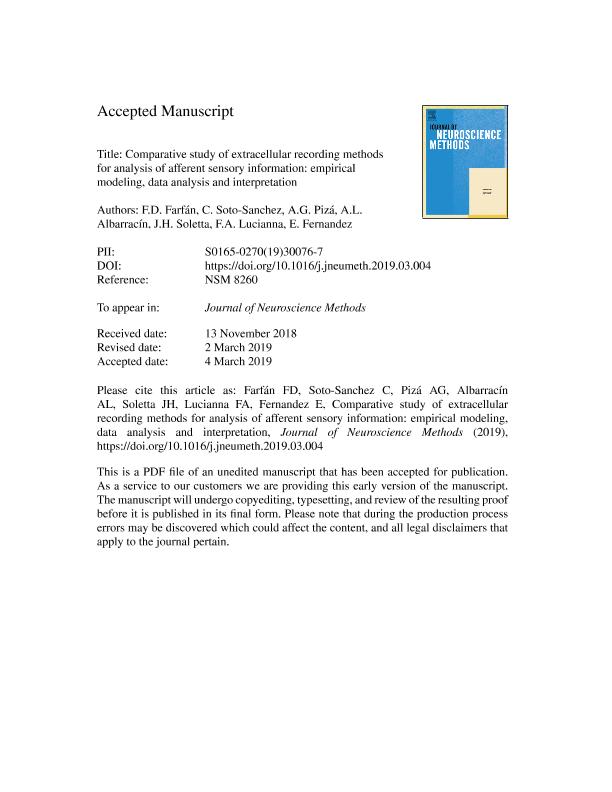Mostrar el registro sencillo del ítem
dc.contributor.author
Farfan, Fernando Daniel

dc.contributor.author
Soto Sanchez, Cristina
dc.contributor.author
Pizá, Alvaro Gabriel

dc.contributor.author
Albarracin, Ana Lia

dc.contributor.author
Soletta, Jorge Humberto

dc.contributor.author
Lucianna, Facundo Adrián

dc.contributor.author
Fernandez, Esteve
dc.date.available
2021-01-05T20:38:56Z
dc.date.issued
2019-05
dc.identifier.citation
Farfan, Fernando Daniel; Soto Sanchez, Cristina; Pizá, Alvaro Gabriel; Albarracin, Ana Lia; Soletta, Jorge Humberto; et al.; Comparative study of extracellular recording methods for analysis of afferent sensory information: Empirical modeling, data analysis and interpretation; Elsevier B.V.; Journal of Neuroscience Methods; 320; 5-2019; 116-127
dc.identifier.issn
0165-0270
dc.identifier.uri
http://hdl.handle.net/11336/121558
dc.description.abstract
Background: Physiological studies of sensorial systems often require the acquisition and processing of data extracted from their multiple components to evaluate how the neural information changes in relation to the environment changes. In this work, a comparative study about methodological aspects of two electrophysiological approaches is described. New method: Extracellular recordings from deep vibrissal nerves were obtained by using a customized microelectrode Utah array during passive mechanical stimulation of rat´s whiskers. These recordings were compared with those obtained with bipolar electrodes. We also propose here a simplified empirical model of the electrophysiological activity obtained from a bundle of myelinated nerve fibers. Results: The peripheral activity of the vibrissal system was characterized through the temporal and spectral features obtained with both recording methods. The empirical model not only allows the correlation between anatomical structures and functional features, but also allows to predict changes in the CAPs morphology when the arrangement and the geometry of the electrodes changes. Comparison with existing method(s): This study compares two extracellular recording methods based on analysis techniques, empirical modeling and data processing of vibrissal sensory information. Conclusions: This comparative study reveals a close relationship between the electrophysiological techniques and the processing methods necessary to extract sensory information. This relationship is the result of maximizing the extraction of information from recordings of sensory activity.
dc.format
application/pdf
dc.language.iso
eng
dc.publisher
Elsevier B.V.

dc.rights
info:eu-repo/semantics/openAccess
dc.rights.uri
https://creativecommons.org/licenses/by-nc-nd/2.5/ar/
dc.subject
EXTRACELLULAR RECORDING
dc.subject
BIPOLAR ELECTRODES
dc.subject
MICROELECTRODE ARRAY
dc.subject
DATA PROCESSING
dc.subject
EMPIRICAL MODELING
dc.subject.classification
Otras Ciencias Biológicas

dc.subject.classification
Ciencias Biológicas

dc.subject.classification
CIENCIAS NATURALES Y EXACTAS

dc.subject.classification
Matemática Aplicada

dc.subject.classification
Matemáticas

dc.subject.classification
CIENCIAS NATURALES Y EXACTAS

dc.title
Comparative study of extracellular recording methods for analysis of afferent sensory information: Empirical modeling, data analysis and interpretation
dc.type
info:eu-repo/semantics/article
dc.type
info:ar-repo/semantics/artículo
dc.type
info:eu-repo/semantics/publishedVersion
dc.date.updated
2020-11-18T16:43:44Z
dc.identifier.eissn
1872-678X
dc.journal.volume
320
dc.journal.pagination
116-127
dc.journal.pais
Países Bajos

dc.journal.ciudad
Amsterdam
dc.description.fil
Fil: Farfan, Fernando Daniel. Consejo Nacional de Investigaciones Científicas y Técnicas. Centro Científico Tecnológico Conicet - Tucumán. Instituto Superior de Investigaciones Biológicas. Universidad Nacional de Tucumán. Instituto Superior de Investigaciones Biológicas; Argentina. Universidad Nacional de Tucumán. Facultad de Ciencias Exactas y Tecnología. Departamento de Bioingeniería. Laboratorio de Medios e Interfases; Argentina
dc.description.fil
Fil: Soto Sanchez, Cristina. Universidad de Miguel Hernández; España. Consorcio Centro de Investigación Biomédica en Red de Bioingeniería, Biomateriales y Nanomedicina; España
dc.description.fil
Fil: Pizá, Alvaro Gabriel. Consejo Nacional de Investigaciones Científicas y Técnicas. Centro Científico Tecnológico Conicet - Tucumán. Instituto Superior de Investigaciones Biológicas. Universidad Nacional de Tucumán. Instituto Superior de Investigaciones Biológicas; Argentina. Universidad Nacional de Tucumán. Facultad de Ciencias Exactas y Tecnología. Departamento de Bioingeniería. Laboratorio de Medios e Interfases; Argentina
dc.description.fil
Fil: Albarracin, Ana Lia. Consejo Nacional de Investigaciones Científicas y Técnicas. Centro Científico Tecnológico Conicet - Tucumán. Instituto Superior de Investigaciones Biológicas. Universidad Nacional de Tucumán. Instituto Superior de Investigaciones Biológicas; Argentina. Universidad Nacional de Tucumán. Facultad de Ciencias Exactas y Tecnología. Departamento de Bioingeniería. Laboratorio de Medios e Interfases; Argentina
dc.description.fil
Fil: Soletta, Jorge Humberto. Consejo Nacional de Investigaciones Científicas y Técnicas. Centro Científico Tecnológico Conicet - Tucumán. Instituto Superior de Investigaciones Biológicas. Universidad Nacional de Tucumán. Instituto Superior de Investigaciones Biológicas; Argentina. Universidad Nacional de Tucumán. Facultad de Ciencias Exactas y Tecnología. Departamento de Bioingeniería. Laboratorio de Medios e Interfases; Argentina
dc.description.fil
Fil: Lucianna, Facundo Adrián. Consejo Nacional de Investigaciones Científicas y Técnicas. Centro Científico Tecnológico Conicet - Tucumán. Instituto Superior de Investigaciones Biológicas. Universidad Nacional de Tucumán. Instituto Superior de Investigaciones Biológicas; Argentina. Universidad Nacional de Tucumán. Facultad de Ciencias Exactas y Tecnología. Departamento de Bioingeniería. Laboratorio de Medios e Interfases; Argentina
dc.description.fil
Fil: Fernandez, Esteve. Universidad de Miguel Hernández; España. Consorcio Centro de Investigación Biomédica en Red de Bioingeniería, Biomateriales y Nanomedicina; España
dc.journal.title
Journal of Neuroscience Methods

dc.relation.alternativeid
info:eu-repo/semantics/altIdentifier/doi/https://doi.org/10.1016/j.jneumeth.2019.03.004
dc.relation.alternativeid
info:eu-repo/semantics/altIdentifier/url/https://www.sciencedirect.com/science/article/abs/pii/S0165027019300767
Archivos asociados
